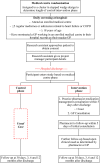Reducing Medical Admissions into Hospital through Optimising Medicines (REMAIN HOME) Study: protocol for a stepped-wedge, cluster-randomised trial
- PMID: 28408545
- PMCID: PMC5719661
- DOI: 10.1136/bmjopen-2016-015301
Reducing Medical Admissions into Hospital through Optimising Medicines (REMAIN HOME) Study: protocol for a stepped-wedge, cluster-randomised trial
Abstract
Introduction: A model of general practitioner (GP) and pharmacist collaboration in primary care may be an effective strategy to reduce medication-related problems and provide better support to patients after discharge. The aim of this study is to investigate whether a model of structured pharmacist and GP care reduces hospital readmissions in high-risk patients.
Methods and analysis: This protocol details a stepped-wedge, cluster-randomised trial that will recruit participants over 9 months with a 12-month follow-up. There will be 14 clusters each representing a different general practice medical centre. A total of 2240 participants will be recruited from hospital who attend an enrolled medical centre, take five or more long-term medicines or whose reason for admission was related to heart failure or chronic obstructive pulmonary disease.The intervention is a multifaceted service, involving a pharmacist integrated into a medical centre to assist patients after hospitalisation. Participants will meet with the practice pharmacist and their GP after discharge to review and reconcile their medicines and discuss changes made in hospital. The pharmacist will follow-up with the participant and liaise with other health professionals involved in the participant's care. The control will be usual care, which usually involves a patient self-organising a visit to their GP after hospital discharge.The primary outcome is the rate of unplanned, all-cause hospital readmissions over 12 months, which will be analysed using a mixed effects Poisson regression model with a random effect for cluster and a fixed effect to account for any temporal trend. A cost analysis will be undertaken to compare the healthcare costs associated with the intervention to those of usual care.
Ethics and dissemination: The study has received ethical approval (HREC/16/QRBW/410). The study findings will be disseminated through peer-reviewed publications, conferences and reports to key stakeholders.
Trial registration number: ACTRN12616001627448.
Keywords: Readmission; collaboration; medication; pharmacist; primary care; stepped-wedge cluster design.
© Article author(s) (or their employer(s) unless otherwise stated in the text of the article) 2017. All rights reserved. No commercial use is permitted unless otherwise expressly granted.
Conflict of interest statement
Figures


References
-
- Australian Council on Safety and Quality in Health Care. Second national report on improving patient safety: improving medication safety. Canberra: Australian Council on Safety and Quality in Health Care, 2002.
Publication types
MeSH terms
Associated data
LinkOut - more resources
Full Text Sources
Other Literature Sources
